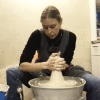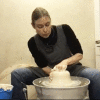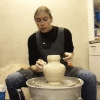An " in vivo" analysis of crafts practices and creativity-Why affordances provide a productive lens
- PMID: 37599710
- PMCID: PMC10436468
- DOI: 10.3389/fpsyg.2023.1127684
An " in vivo" analysis of crafts practices and creativity-Why affordances provide a productive lens
Abstract
Scholars are increasingly recognizing that creativity is grounded in the active sensorimotor engagement with the environment and materiality. Affordances-recognizable pointers to action opportunities in the ecology-provide a helpful prism for analyzing how this happens. Creative practitioners, as they seek aesthetic opportunities or innovation, depend on their sensitivity toward potentialities in their action space. Presently, we apply a high-zoom lens to a crafts process, giving our micro-genetic research design an affordance focus. By investigating one of the authors, a ceramicist and a practitioner-researcher, through her process of making of a vase, we tracked how affordances are responded to, developed, shaped, invited or, where necessary, rejected, as the ceramicist "routes" her creative trajectory. Several insights emerge: (1) The ceramicist's decisions-initially about general directions, then about aesthetic details-unfold while engaging with the clay; they emerge in stepwise fashion, but with a holistic orientation. (2) Choosing among affordances requires parallel sensitivities to object functionality, aesthetics and creativity, as well as technical feasibility; adhering to the proper technical procedure that provides the very basis for creatively relevant affordances to later arise. (3) While the hands and eyes engage with short-lived affordances the ceramicist must keep in view higher-timescale affordances that ensure a good task progression for making a vase, and affordances for the material's overall "workability". (4) The ceramicist typically relates to momentary affordances in light of expected as well as imagined others, to ensure a coherent end product. (5) Affordances contribute to material creativity in more ways than typically recognized in the literature. They range from serendipitous "finds" to options developed with a large degree of creative autonomy; affordances may also be indirectly invited and practitioners strategically change probability distributions as well as providing an enabling background for generative action. Thus, a crafts practitioner brings forth unconventional affordances through active engagement, using a mix of exploration, strategy, and imaginative potential. Affordance theorists err when stressing the possibility to just "find" creative options or that perceptual acuity is the sole skill.
Keywords: affordances; crafts; creativity; ecological psychology; interactivity; material engagement; micro-genetic analysis.
Copyright © 2023 Kimmel and Groth.
Conflict of interest statement
The authors declare that the research was conducted in the absence of any commercial or financial relationships that could be construed as a potential conflict of interest.
Figures







Similar articles
-
What affords being creative? Opportunities for novelty in light of perception, embodied activity, and imaginative skill.Adapt Behav. 2024 Jun;32(3):225-242. doi: 10.1177/10597123231179488. Epub 2023 Jun 16. Adapt Behav. 2024. PMID: 38736469 Free PMC article.
-
Plurilingualism as a Catalyst for Creativity in Superdiverse Societies: A Systemic Analysis.Front Psychol. 2017 Dec 22;8:2169. doi: 10.3389/fpsyg.2017.02169. eCollection 2017. Front Psychol. 2017. PMID: 29312046 Free PMC article.
-
Situated imagination.Phenomenol Cogn Sci. 2025;24(2):455-477. doi: 10.1007/s11097-020-09701-2. Epub 2020 Sep 3. Phenomenol Cogn Sci. 2025. PMID: 40099166 Free PMC article.
-
Creative Collaboration and Collaborative Creativity: A Systematic Literature Review.Front Psychol. 2021 Aug 9;12:713445. doi: 10.3389/fpsyg.2021.713445. eCollection 2021. Front Psychol. 2021. PMID: 34434151 Free PMC article.
-
Social affordances and the possibility of ecological linguistics.Integr Psychol Behav Sci. 2009 Dec;43(4):356-73. doi: 10.1007/s12124-009-9097-8. Integr Psychol Behav Sci. 2009. PMID: 19609627 Review.
Cited by
-
Created stepping-stone configurations depend on task constraints.Q J Exp Psychol (Hove). 2024 Nov;77(11):2283-2295. doi: 10.1177/17470218241242420. Epub 2024 Apr 10. Q J Exp Psychol (Hove). 2024. PMID: 38485517 Free PMC article.
-
What affords being creative? Opportunities for novelty in light of perception, embodied activity, and imaginative skill.Adapt Behav. 2024 Jun;32(3):225-242. doi: 10.1177/10597123231179488. Epub 2023 Jun 16. Adapt Behav. 2024. PMID: 38736469 Free PMC article.
References
-
- Aktaş B. M. (2019). Using wool's agency to design and make felted artefacts. Ruukku Stud. Artistic Res. 10, 1-19. 10.22501/ruu.453632 - DOI
-
- Amabile T. (1996). Creativity in Context. Boulder, CO: Westview Press.
-
- Baber C. (2015). Thinking through tools: what can tool-use tell us about distributed cognition? studies in logic. Grammar Rhetor. 41, 25–40. 10.1515/slgr-2015-0018 - DOI
-
- Baber C. (2021). Embodying Design: An Applied Science of Radical Embodied Cognition. Cambridge, MA: The MIT Press. 10.7551/mitpress/12419.001.0001 - DOI
-
- Baber C., Chemero T., Hall J. (2019). What the jeweller's hand tells the jeweller's brain: tool use, creativity and embodied cognition. Philos. Technol. 32, 283–302. 10.1007/s13347-017-0292-0 - DOI
LinkOut - more resources
Full Text Sources

